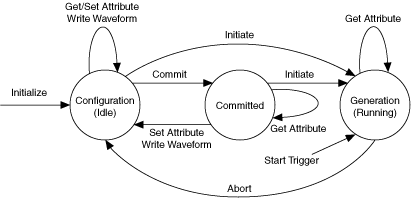NI-RFSG Programming State Model
The NI-RFSG programming model has three main states: Configuration (Idle), Committed, and Generation (Running). The following programming state model depicts the programming state model for the NI-RFSG hardware and software.

| Configuration | You can program all session properties in the Configuration state. However, when the hardware module is in the Configuration state, the properties have not yet been applied. Therefore, the module configuration may not match the session property values. The NI-RFSG device does not generate a signal in the Configuration state.
 |
Note When you read a property, NI-RFSG may analyze many properties in the current configuration in order to return the coerced value for that property. In general, avoid reading any properties until you have finished changing all the properties you would like to change. Otherwise, you may encounter errors if a property is read while the configuration is in an inconsistent state. |
|
| Committed | Calling the niRFSG Commit VI or the niRFSG_Commit function from the Committed state performs the following actions:
- Verifies all property settings
- Validates the specified configuration
- Writes all settings to the hardware modules
- Writes the waveform to the AWG module onboard memory
- Transitions to the Committed state
If any properties are changed while in the Committed state, the session implicitly transitions back to the Configuration state and the hardware configuration reflects the previously committed properties.
|
| Generation | In the Generation state, session properties always reflect the current state of the module, and the module is either waiting on a trigger or generating a signal.
 |
Note For the NI 5670/5671 devices, you cannot write any properties during the Generation state. However, the NI 5650/5651/5652 device family does allow some attributes to be changed during the Generation state.
|
|
 |
Note The niRFSG Close VI or the niRFSG_close function may be called from any state. Calling this VI or function stops signal generation. |

